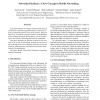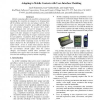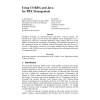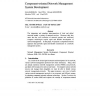WMCSA
2000
IEEE
14 years 4 months ago
2000
IEEE
Networked Surfaces are surfaces which provide network connectivity to specially augmented objects, when these objects are physically placed on top of the surface. When an object (...
WMCSA
2000
IEEE
14 years 4 months ago
2000
IEEE
Prior work has shown the value of changing application fidelity to adapt to varying resource levels in a mobile environment. Choosing the right fidelity requires us to predict i...
WMCSA
2000
IEEE
14 years 4 months ago
2000
IEEE
WMCSA
2000
IEEE
14 years 4 months ago
2000
IEEE
In mobile computing, context-awareness indicates the ability of a system to obtain and use information on aspects of the system environment. To implement contextawareness, mobile ...
WMCSA
2000
IEEE
14 years 4 months ago
2000
IEEE
Mobile computing offers the possibility of dramatically expanding the versatility of computers, by bringing them off the desktop and into new and unique contexts. However, this ne...
WMCSA
2000
IEEE
14 years 4 months ago
2000
IEEE
The Post-PC revolution is bringing information access to a wide-range of devices beyond the desktop, such as public kiosks, and mobile devices like cellular telephones, PDAs, and ...
WMCSA
2000
IEEE
14 years 4 months ago
2000
IEEE
Mobile systems operate in a resource-scarce environment and thus must adapt to external conditions; all layers must make cost-based decisions about what mode of operation to use i...
WMCSA
2000
IEEE
14 years 4 months ago
2000
IEEE
The thin client model is uniquely suited for lowbandwidth mobile environments, where resource-poor devices may need to access critical applications over wireless networks. In this...
NOMS
2000
IEEE
14 years 4 months ago
2000
IEEE
Telephone Switches are characteristically long-lived, evolving systems. We describe how a legacy two-tier system for telephone switch management was reengineered as a three-tier w...
NOMS
2000
IEEE
14 years 4 months ago
2000
IEEE





